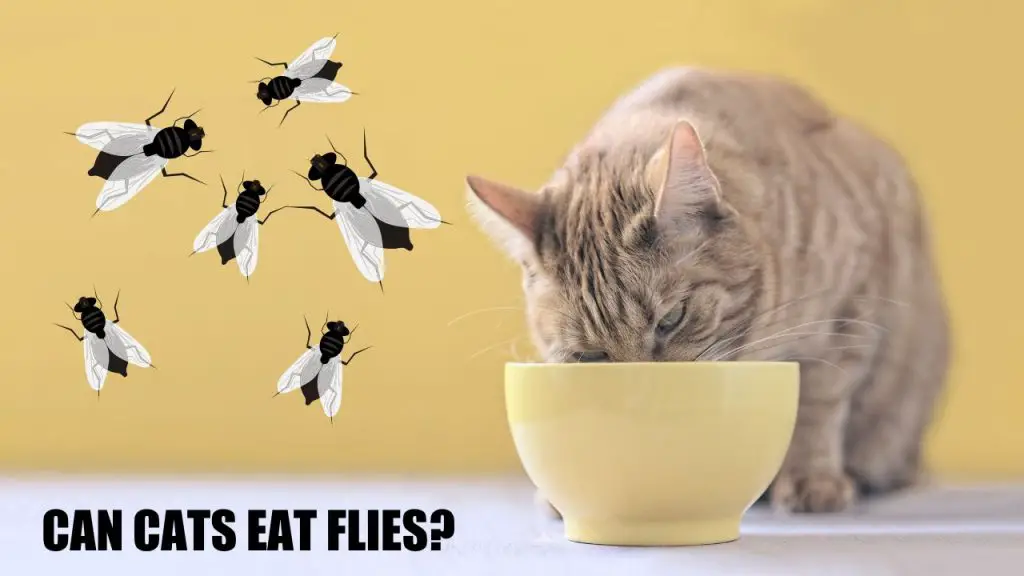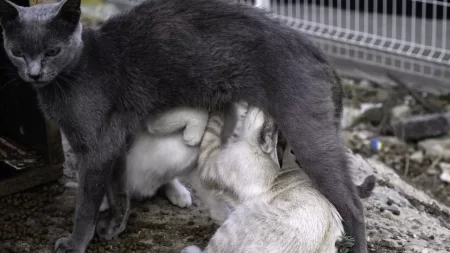Many cat owners may wonder whether cats can eat flies. The simple answer is yes, cats can eat flies. In fact, files are a good source of nutrition, and some in countries humans consume them too.
Although flies don’t pose an immediate danger to cats, it’s crucial to understand that regularly providing flies to your cat isn’t advisable. While there isn’t any significant nutritional benefit to consuming flies, it’s essential to note that feeding your cat these insects is not recommended.
Veterinarians and pet owners generally don’t recommend cats eat flies. Flies may be attracted to cats because of their scent. But, flies also carry harmful bacteria like salmonella and E. coli. These germs can make your cat sick. So, it is best not to let your cat eat any kind of fly or insect.
Furthermore, flies are small and fragile. So, if cats eat them too quickly or in large amounts, they can choke on them. It is important for pet owners to monitor their cats when eating insects.
Generally, it is advised to avoid cats eating flies. Knowing the risks will help you decide if this behavior should be allowed at home.
The Nutritional Benefits of Flies
It may come as a surprise, but flies can actually provide some nutritional benefits. Studies have found that fly larvae meal (FLM) contains a substantial 54% protein and 22% lipid content, and has a microbiological activity that is appropriate for consumption. The FLM is a valuable source of nutrition because it consists of significant quantities of essential amino acids including leucine, lysine and cysteine. Additionally, it contains unsaturated fatty acids such as oleic, linoleic, and palmitoleic which are significant for good health.
How Flies are Consumed by Humans in Different Countries?
Flies are a surprising food source, yet many countries worldwide consider them a delicacy. Insects, including flies, serve as a frequent protein source for individuals residing in countries such as Thailand, Laos, and Mexico. For instance, in Thailand, fried bamboo worms and crickets represent popular snacks, while in Mexico, fried fly larvae are a traditional dish. Mulberry and wild silkworms, crickets, beetles, and other insects are also commonly consumed in India. Though Western cultures may not have a habit of eating insects, some food products and supplements still use them. Flies typically function as bait for fishing, and their larvae are a protein source for fish and other animals. Despite appearing unconventional to some, consuming flies and other insects is an age-old tradition in numerous cultures that can provide valuable nutrition.
How Cats Can Safely Consume Flies?
Cats crave bugs, which are part of their diet. But caution is advised when they eat flies. Wild flies could carry parasites and diseases that cats in captivity can’t fight off.
Before allowing your cat to eat a fly, make sure it’s safe. If you want your cat to eat flies, there are alternatives. Pet-safe fly attractants have vitamins and minerals added for safety. Freeze-dried fly treats from pet food brands are also safe since they are frozen before feeding.
If you don’t want to offer a wild game or pre-packaged treats, grow plants indoors using organic compost. This provides a fun activity and access to fresh, safe insects like flies.
Potential Health Risks of Eating Flies for Cats
Many cats have been known to catch and eat flies. However, the safety of this behavior is not confirmed. Flies may contain minerals, proteins, vitamins, and antioxidants, but also contain potential risks. Cats that eat flies could be ingesting larvae and fly feces, which could cause infection or parasites. They can also transmit bacteria or viruses, and in rare cases, toxins in pesticides or other chemicals. Allergic reactions and internal blockages from sharp body parts are also possible.
Owners need to be aware of the risks of their cats eating flies and take steps to prevent it. Ideas include:
- Keeping windows screened
- Eliminating standing water
- Removing garbage cans
- Covering pet food leftovers
- Installing bug zappers
It’s best to keep cats indoors during summer months when there are more flies present, as they’re attracted to warm temperatures and food scraps outside.
Different Types of Flies Cats Can Eat
Cats can eat several types of flies, such as mosquitoes, moths, and houseflies. But whether cats like eating them is another thing. However, chasing them and biting them is something cats enjoy.
Some flies though, are not safe for cats to consume. They can carry bacteria and parasites which can make cats ill. Also, certain wildlife-based species may contain pesticides or chemicals that can be toxic.
- Mosquitoes are relatively safe for cats. But, eating too many can cause digestive upset and possible malnutrition.
- Moths contain vitamins, minerals, and protein. It is important to monitor how many moths your cat is eating, to keep a balanced diet.
- Houseflies should be avoided. They often feed on decaying organic matter, which may contain disease-causing organisms.
- Plant-based insects like crickets, or mealworms, are better options. They have more nutritional value than processed dried insects found at specialty stores.
Are There Any Diseases Or Parasites That Can Be Transmitted To Cats By Eating Flies?
Several diseases and parasites can transmit to cats through the consumption of flies. Flies, ticks, and mosquitoes can carry disease-causing organisms that enter a pet’s bloodstream. Lyme disease and Mycoplasma, for instance, transmit to cats via ticks. Flies can also give cats worms, and some even burrow into their fur as parasites. Rodents carrying Echinococcus can infect dogs and cats if they eat them. Pet owners must monitor their pets’ behavior and prevent them from consuming infected insects to keep them safe.
Is There A Difference In The Impact Of Eating Live Or Dead Flies On A Cat’s Health?
Typically, eating live or dead flies doesn’t significantly impact a cat’s health. Flies aren’t harmful to cats as long as they’re disease-free and toxin-free. Adult cats have a robust digestive system and can consume small prey, such as flies, entirely. Nevertheless, it’s worth noting that ingesting exoskeletons from flies may cause digestive upset or pose a choking risk for cats. As with any food, it’s prudent to monitor your cat’s intake of flies and consult a veterinarian if you notice any worrying symptoms or actions.
Conclusion
Cats can eat flies, but caution should be taken. Too many could give them an upset stomach. Additionally, flies may also transfer internal parasites to cats. Therefore, it is best to limit their intake of flies and other insects.Provide your cat with a balanced diet that has proteins and vitamins from a variety of sources. This will help keep them healthy and reduce the desire to eat insects. If you notice your cat eating flies or any other type of insect, try to stop it. Speak to your vet if you are worried about the safety of allowing your cat to eat insects.







